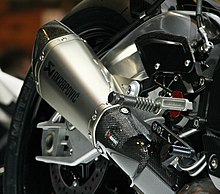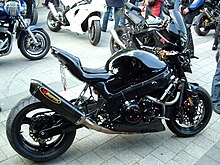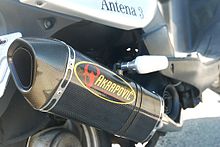 | |
 | |
| Company type | Private |
|---|---|
| Founded | 1990 |
| Founder | Igor Akrapovič |
| Headquarters | , |
Key people | Igor Akrapovič |
| Products | Car and Motorcycle exhausts |
| Revenue | €107 million (2017) [1] |
| €16 million (2017) [1] | |
Number of employees | 1400 |
| Website |
www |
Akrapovič d.d. (Slovene pronunciation: [aˈkrapɔʋitʃ]) is a Slovenian manufacturer of exhaust systems that began in 1990 in the motorcycle market, and expanded into automobile exhausts in 2010. [2] [3] A global exhaust supplier in motorcycle sport, [4] [5] Akrapovič exhausts are used on motorcycles in Moto GP, [6] superbike, [7] [8] supersport, supermoto, motocross, enduro and rally raid. As of May 2010 [update], Akrapovič systems have been used in a total of 38 world championships, all across motorsport. [9]
History
Igor Akrapovič began motorcycle racing in 1977 in 250 GP two-strokes, then 1000 cc four-strokes in F1 Open Class, and then in Superbike class by the end of his racing in 1988-1989. [2] He founded a motorcycle tuning shop, Skorpion, with a staff of six, where they made their own exhausts because higher quality Western aftermarket exhausts were too expensive, and those made in the Eastern Bloc were of inadequate quality. [2] Akrapovič says he was motivated by the poor quality of aftermarket exhausts available to the public compared to those used by professional racing teams. [10] He said that the welded pipes on the market had walls that were too thick, and that racing-quality systems were too expensive and difficult for the average customer to obtain. [10] He designed his own exhaust system, which was sufficient to his requirements, based on the experience gained in the field of motorcycle tuning. Steel was replaced with materials such as carbon fibre and titanium. [10]

In 1993, Kawasaki in Germany tested the exhaust systems and in 1994, Akrapovič exhausts were first used in international competition, in the ESBK and WSBK. [10] Other Pro Superbike championship teams, Yamaha, Suzuki, Ducati and Honda also began using Akrapovič exhausts. [10]

In 1997, the company changed its name from Skorpion to Akrapovič and that year Akira Yanagawa became the first racer to win a race using an Akrapovič exhaust on a Kawasaki bike. [10] After a strong growth in sales, particularly from Germany, with a growth as high as 70% per annum, [1] production capacity was expanded in 1999, moving location from a 450 m2 (4,800 sq ft) workshop to a then 3,000 m2 (32,000 sq ft) factory in Ivančna Gorica. [10] This factory has since more than quadrupled in size to 13,000 m2 (140,000 sq ft) as of 2010 [update].[ citation needed]
In 2000, the first world championship title using an Akrapovič exhaust was won in the WSBK when Colin Edwards won the world championship title on his Castrol Honda SP-01. [10] [11] That year, the 600 SS class with Yamaha and Jörg Teuchert also won using an Akrapovič exhaust. Modifications made to the design saw the company enter into the American AMA Superbike and the Japanese All Japan Superbike Championship and then in 2002, the MotoGP class, forming an alliance with the Honda, Kawasaki and Aprilia factory teams. [10]
As income increased, the company invested in new technology and modernization, upgrading computers in 3-D planning of configurations, programming of tools and computer-aided manufacture. [10] In 2004, the company made its first contact with automobile industry and in 2007 developed and equipped an exhaust system for a Formula 1 race car. [10] In 2007, the company changed its logo. Akrapovič is now active as a supplier in the Porsche Sport Cup, where Porsche cars compete in six fully licensed and unlicensed series. [10] In April 2007, the company was awarded the Best Exhaust Pipe Manufacturer Award from German Motorrad magazine, winning 42% of the votes. The company has since won the Best Brand award in every subsequent year, with 2011 by its highest ever margin of votes. [1]
Partnerships

The company partners with motorcycle manufacturers such as Yamaha, [12] who offer Akrapovič cans as optional factory- or dealer-fit equipment on the R1, [13] and MT-01; [14] and BMW Motorrad who offer an Akrapovič can as standard on the R nineT, S1000R, F800R, [15] HP2 Megamoto, [16] and as an option on most other bikes in their range. [17] The exhausts are also on Kawasaki racing bikes, such as the Z1000, as well as Honda, Aprilia and Suzuki. [18] [19] [20] [21] Akrapovič supplies the exhaust systems for Audi's LMP cars since 2009 and is an official Audi Sport partner for the first time in the 2012 season, Audi R18 and Audi A5 DTM. [22] Many of the leading motorcyclists in the Supersport series are known to ride with Akrapovič fitted exhausts including Roger Lee Hayden who has one fitted to his Kawasaki. [23]
Production



Akrapovič's titanium foundry is in an 800 m2 (8,600 sq ft) building at the company's main location in Ivančna Gorica. [24] The casting process involves gas injection, X-ray radioscopy, and various chemical analyses, aided by CAD/CAM/CAE tools. The company also manufactures a titanium range called the Akrapovič Evolution. [25]
References
- ^ a b c d "Igor Akrapovic Interview" (PDF). Sinfo. Government of Slovenia: 15–18. April 2007.[ permanent dead link]
- ^ a b c Cathcart, Alan (19 November 2010), Akrapovic Exhausts Factory - The Sign of the Skorpion; A visit with the man behind Akrapovic Exhaust Systems Technology, archived from the original on 9 October 2017, retrieved 25 June 2017
- ^ Peterson, Pete (25 May 2010). "Akrapovic Factory Tour - Dirt Rider Magazine". Dirt Bike. ISSN 0735-4355.
- ^ Simon, Hermann (2009). Hidden Champions of the Twenty-First Century: The Success Strategies of Unknown World Market Leaders. Springer. ISBN 978-0-387-98146-8.
- ^ Prašnikar, J. (2006). Competitiveness, social responsibility and economic growth. Nova Publishers. p. 275. ISBN 1-59454-811-0.
- ^ "Rizla Suzuki MotoGP Team Partners". Rizla Suzuki. Archived from the original on 2010-05-23. Retrieved 8 June 2010.
- ^ "Akrapovic for 2007 R1". Superbike Magazine. 11 January 2007. ISSN 1351-5683. Archived from the original on 22 January 2010. Retrieved 8 June 2010.
- ^ "Sponsors". Yamaha World Superbike Team. Archived from the original on 2 December 2009. Retrieved 8 June 2010.
- ^ "A is for Akrapovič". BMW Motorrad. May 2010. Archived from the original on 8 July 2011. Retrieved 8 June 2010.
- ^ a b c d e f g h i j k l "Our Story". Akrapovič. Archived from the original on 2010-06-04. Retrieved 8 June 2010.
- ^ "Colin Edwards". Eurosport. Archived from the original on 26 June 2010. Retrieved 8 June 2010.
- ^ Walneck's Classic Cycle Trader. Dominion Enterprises. p. 155.
- ^ "R1 Akrapovic Offer". Yamaha Motor Company. Retrieved 8 June 2010.
- ^ "Motorcycle reviews: Yamaha MT-01 (2005-current)". Motorcycle News. Retrieved 8 June 2010.
- ^ "BMW F800R". BMW Motorrad. Archived from the original on 2010-05-28. Retrieved 8 June 2010.
- ^ Ash, Kevin (9 February 2008). "BMWs Megamoto: The beast with the angry edge". The Daily Telegraph. Archived from the original on 29 May 2010. Retrieved 8 June 2010.
- ^ "Motorcycle Equipment 2009/2010". BMW Motorrad. pp. 66–71. Archived from the original on 3 March 2016. Retrieved 8 June 2010.
- ^ "Z1000". Kawasaki. Archived from the original on 17 June 2010. Retrieved 8 June 2010.
- ^ "AKRAPOVIC EXHAUST SYSTEMS - HONDA". Racing Exhausts. Retrieved 8 June 2010.
- ^ Miro De Cet (2004). Essential Superbike. MotorBooks International. p. 11. ISBN 0-7603-2007-1.
- ^ Neely, David (27 May 2010). "Time to ride off with a great deal". The Belfast Telegraph. Retrieved 8 June 2010.
- ^ "Comeback of quattro drive in motor sport". April 4, 2012. Retrieved August 8, 2019.
- ^ Cycle World, Volume 45, 2006, CBS Publications
- ^ "Investment Casting of Titanium". Akrapovič. Archived from the original on 7 June 2010. Retrieved 8 June 2010.
- ^ "SR Tested: KTM Twins Parts for KTM Super Duke R". Sport Rider Magazine. June 2010. Retrieved 8 June 2010.
Further reading
- Akrapovič, I; Ambrožič, J., Najboljše izpušne cevi izdelujejo pri Akrapoviču: Igor Akrapovič - osebnost leta 2005 (in Slovene)
- Vadnjal, J., Akrapovič - tehnični in finančni genij (in Slovene)
External links
![]() Media related to
Akrapovič at Wikimedia Commons
Media related to
Akrapovič at Wikimedia Commons
 | |
 | |
| Company type | Private |
|---|---|
| Founded | 1990 |
| Founder | Igor Akrapovič |
| Headquarters | , |
Key people | Igor Akrapovič |
| Products | Car and Motorcycle exhausts |
| Revenue | €107 million (2017) [1] |
| €16 million (2017) [1] | |
Number of employees | 1400 |
| Website |
www |
Akrapovič d.d. (Slovene pronunciation: [aˈkrapɔʋitʃ]) is a Slovenian manufacturer of exhaust systems that began in 1990 in the motorcycle market, and expanded into automobile exhausts in 2010. [2] [3] A global exhaust supplier in motorcycle sport, [4] [5] Akrapovič exhausts are used on motorcycles in Moto GP, [6] superbike, [7] [8] supersport, supermoto, motocross, enduro and rally raid. As of May 2010 [update], Akrapovič systems have been used in a total of 38 world championships, all across motorsport. [9]
History
Igor Akrapovič began motorcycle racing in 1977 in 250 GP two-strokes, then 1000 cc four-strokes in F1 Open Class, and then in Superbike class by the end of his racing in 1988-1989. [2] He founded a motorcycle tuning shop, Skorpion, with a staff of six, where they made their own exhausts because higher quality Western aftermarket exhausts were too expensive, and those made in the Eastern Bloc were of inadequate quality. [2] Akrapovič says he was motivated by the poor quality of aftermarket exhausts available to the public compared to those used by professional racing teams. [10] He said that the welded pipes on the market had walls that were too thick, and that racing-quality systems were too expensive and difficult for the average customer to obtain. [10] He designed his own exhaust system, which was sufficient to his requirements, based on the experience gained in the field of motorcycle tuning. Steel was replaced with materials such as carbon fibre and titanium. [10]

In 1993, Kawasaki in Germany tested the exhaust systems and in 1994, Akrapovič exhausts were first used in international competition, in the ESBK and WSBK. [10] Other Pro Superbike championship teams, Yamaha, Suzuki, Ducati and Honda also began using Akrapovič exhausts. [10]

In 1997, the company changed its name from Skorpion to Akrapovič and that year Akira Yanagawa became the first racer to win a race using an Akrapovič exhaust on a Kawasaki bike. [10] After a strong growth in sales, particularly from Germany, with a growth as high as 70% per annum, [1] production capacity was expanded in 1999, moving location from a 450 m2 (4,800 sq ft) workshop to a then 3,000 m2 (32,000 sq ft) factory in Ivančna Gorica. [10] This factory has since more than quadrupled in size to 13,000 m2 (140,000 sq ft) as of 2010 [update].[ citation needed]
In 2000, the first world championship title using an Akrapovič exhaust was won in the WSBK when Colin Edwards won the world championship title on his Castrol Honda SP-01. [10] [11] That year, the 600 SS class with Yamaha and Jörg Teuchert also won using an Akrapovič exhaust. Modifications made to the design saw the company enter into the American AMA Superbike and the Japanese All Japan Superbike Championship and then in 2002, the MotoGP class, forming an alliance with the Honda, Kawasaki and Aprilia factory teams. [10]
As income increased, the company invested in new technology and modernization, upgrading computers in 3-D planning of configurations, programming of tools and computer-aided manufacture. [10] In 2004, the company made its first contact with automobile industry and in 2007 developed and equipped an exhaust system for a Formula 1 race car. [10] In 2007, the company changed its logo. Akrapovič is now active as a supplier in the Porsche Sport Cup, where Porsche cars compete in six fully licensed and unlicensed series. [10] In April 2007, the company was awarded the Best Exhaust Pipe Manufacturer Award from German Motorrad magazine, winning 42% of the votes. The company has since won the Best Brand award in every subsequent year, with 2011 by its highest ever margin of votes. [1]
Partnerships

The company partners with motorcycle manufacturers such as Yamaha, [12] who offer Akrapovič cans as optional factory- or dealer-fit equipment on the R1, [13] and MT-01; [14] and BMW Motorrad who offer an Akrapovič can as standard on the R nineT, S1000R, F800R, [15] HP2 Megamoto, [16] and as an option on most other bikes in their range. [17] The exhausts are also on Kawasaki racing bikes, such as the Z1000, as well as Honda, Aprilia and Suzuki. [18] [19] [20] [21] Akrapovič supplies the exhaust systems for Audi's LMP cars since 2009 and is an official Audi Sport partner for the first time in the 2012 season, Audi R18 and Audi A5 DTM. [22] Many of the leading motorcyclists in the Supersport series are known to ride with Akrapovič fitted exhausts including Roger Lee Hayden who has one fitted to his Kawasaki. [23]
Production



Akrapovič's titanium foundry is in an 800 m2 (8,600 sq ft) building at the company's main location in Ivančna Gorica. [24] The casting process involves gas injection, X-ray radioscopy, and various chemical analyses, aided by CAD/CAM/CAE tools. The company also manufactures a titanium range called the Akrapovič Evolution. [25]
References
- ^ a b c d "Igor Akrapovic Interview" (PDF). Sinfo. Government of Slovenia: 15–18. April 2007.[ permanent dead link]
- ^ a b c Cathcart, Alan (19 November 2010), Akrapovic Exhausts Factory - The Sign of the Skorpion; A visit with the man behind Akrapovic Exhaust Systems Technology, archived from the original on 9 October 2017, retrieved 25 June 2017
- ^ Peterson, Pete (25 May 2010). "Akrapovic Factory Tour - Dirt Rider Magazine". Dirt Bike. ISSN 0735-4355.
- ^ Simon, Hermann (2009). Hidden Champions of the Twenty-First Century: The Success Strategies of Unknown World Market Leaders. Springer. ISBN 978-0-387-98146-8.
- ^ Prašnikar, J. (2006). Competitiveness, social responsibility and economic growth. Nova Publishers. p. 275. ISBN 1-59454-811-0.
- ^ "Rizla Suzuki MotoGP Team Partners". Rizla Suzuki. Archived from the original on 2010-05-23. Retrieved 8 June 2010.
- ^ "Akrapovic for 2007 R1". Superbike Magazine. 11 January 2007. ISSN 1351-5683. Archived from the original on 22 January 2010. Retrieved 8 June 2010.
- ^ "Sponsors". Yamaha World Superbike Team. Archived from the original on 2 December 2009. Retrieved 8 June 2010.
- ^ "A is for Akrapovič". BMW Motorrad. May 2010. Archived from the original on 8 July 2011. Retrieved 8 June 2010.
- ^ a b c d e f g h i j k l "Our Story". Akrapovič. Archived from the original on 2010-06-04. Retrieved 8 June 2010.
- ^ "Colin Edwards". Eurosport. Archived from the original on 26 June 2010. Retrieved 8 June 2010.
- ^ Walneck's Classic Cycle Trader. Dominion Enterprises. p. 155.
- ^ "R1 Akrapovic Offer". Yamaha Motor Company. Retrieved 8 June 2010.
- ^ "Motorcycle reviews: Yamaha MT-01 (2005-current)". Motorcycle News. Retrieved 8 June 2010.
- ^ "BMW F800R". BMW Motorrad. Archived from the original on 2010-05-28. Retrieved 8 June 2010.
- ^ Ash, Kevin (9 February 2008). "BMWs Megamoto: The beast with the angry edge". The Daily Telegraph. Archived from the original on 29 May 2010. Retrieved 8 June 2010.
- ^ "Motorcycle Equipment 2009/2010". BMW Motorrad. pp. 66–71. Archived from the original on 3 March 2016. Retrieved 8 June 2010.
- ^ "Z1000". Kawasaki. Archived from the original on 17 June 2010. Retrieved 8 June 2010.
- ^ "AKRAPOVIC EXHAUST SYSTEMS - HONDA". Racing Exhausts. Retrieved 8 June 2010.
- ^ Miro De Cet (2004). Essential Superbike. MotorBooks International. p. 11. ISBN 0-7603-2007-1.
- ^ Neely, David (27 May 2010). "Time to ride off with a great deal". The Belfast Telegraph. Retrieved 8 June 2010.
- ^ "Comeback of quattro drive in motor sport". April 4, 2012. Retrieved August 8, 2019.
- ^ Cycle World, Volume 45, 2006, CBS Publications
- ^ "Investment Casting of Titanium". Akrapovič. Archived from the original on 7 June 2010. Retrieved 8 June 2010.
- ^ "SR Tested: KTM Twins Parts for KTM Super Duke R". Sport Rider Magazine. June 2010. Retrieved 8 June 2010.
Further reading
- Akrapovič, I; Ambrožič, J., Najboljše izpušne cevi izdelujejo pri Akrapoviču: Igor Akrapovič - osebnost leta 2005 (in Slovene)
- Vadnjal, J., Akrapovič - tehnični in finančni genij (in Slovene)
External links
![]() Media related to
Akrapovič at Wikimedia Commons
Media related to
Akrapovič at Wikimedia Commons